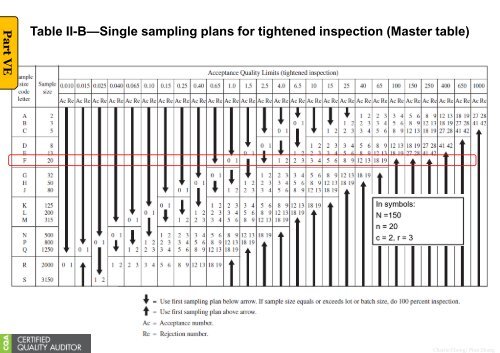My Reading on ASQ CQA HB Part V Part 2
You also want an ePaper? Increase the reach of your titles
YUMPU automatically turns print PDFs into web optimized ePapers that Google loves.
Charlie Ch<strong>on</strong>g/ Fi<strong>on</strong> Zhang<br />
<strong>Part</strong> VE<br />
Judgmental Sampling- Not Statistically Valid<br />
Judgmental sampling can be used by auditors to get a pretty good idea of what is happening, although the<br />
results are not statistically valid. In the first approach, the auditor selects samples based <strong>on</strong> his or her best<br />
judgment of what is believed to give a representative picture of the populati<strong>on</strong>. These samples are chosen<br />
based <strong>on</strong> the auditor’s past experience. Often these samples are taken from areas that expose the company to<br />
the greatest risk, such as high-dollar orders, special orders, or critical applicati<strong>on</strong> orders.<br />
The auditor may already know from past history (past audits) that problems have existed in department A,<br />
activity C, and with this knowledge, the auditor examines that area in an audit. In judgmental sampling, the<br />
auditor may also decide to look at all orders over $2 milli<strong>on</strong> or all orders destined for installati<strong>on</strong> in the military<br />
aircraft. If a problem is found, the auditor examines additi<strong>on</strong>al samples to determine the extent of the<br />
immediate problem. In the sec<strong>on</strong>d approach (that is, looking at all orders over $2 milli<strong>on</strong>), the process or<br />
system has reached maturity, and very few problems are identified in a general audit using random sample<br />
techniques. The company may then decide to audit all areas in which problems were identified, with the<br />
intenti<strong>on</strong> of determining whether the activity can be improved bey<strong>on</strong>d its current level.<br />
The nuclear industry and several other industries have reached this point and have begun to rely <strong>on</strong><br />
judgmental sampling to identify areas for improvement.<br />
The pro side of judgmental sampling is extensive. The auditor focuses <strong>on</strong> areas where previous problems were<br />
found and corrected. High-risk areas and activities historically have received the most attenti<strong>on</strong> from<br />
management. By doing judgmental sampling, the auditor will be providing informati<strong>on</strong> <strong>on</strong> areas known to be of<br />
interest to management. Judgmental sampling allows companies to focus their efforts <strong>on</strong> specific<br />
improvements rather than general assessment. It allows the auditor to more effectively use his or her time<br />
during the audit. And finally, selecti<strong>on</strong> of the audit sample is relatively simple, which leaves more time to<br />
prepare for and perform the audit.

















